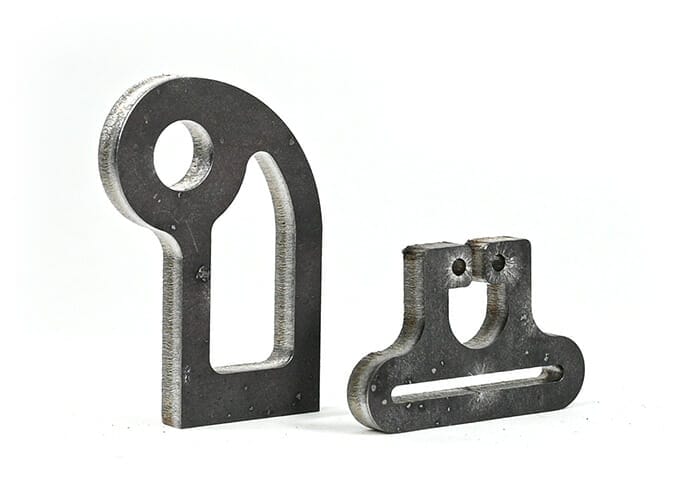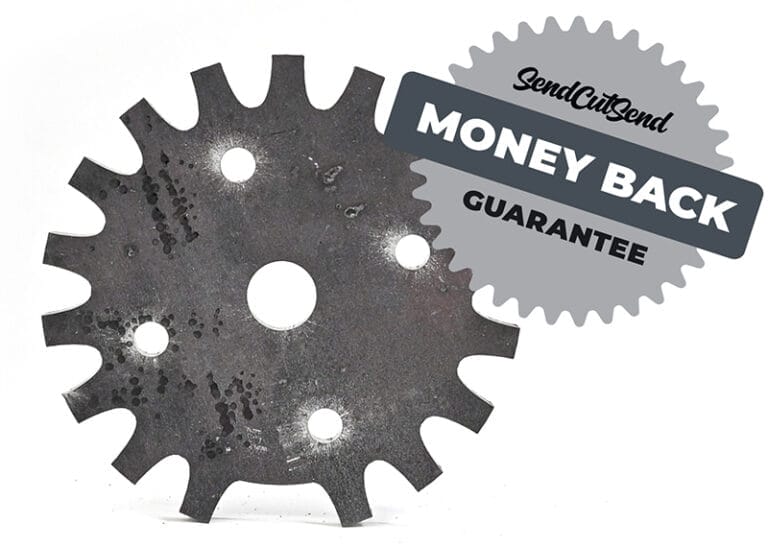One of two abrasion-resistant grade steels offered here at SendCutSend, AR400 steel is formulated to take a massive amount of punishment and abuse. Used in shooting range targets, armor plating, and quarry machinery, this material is ready to provide your projects with toughness and durability.
Instant quote
A: .25″ x .375″
B: 30″ x 44″
Custom quote
C: 30″ x 56″
.250″ (6.35mm)

AR400 Steel is a high-strength, abrasion-resistant alloy that is specifically engineered to withstand wear and impact in challenging environments. It has exceptional durability and resistance to surface abrasion and gouging.
You’ll find this steel in applications such as construction machinery, mining equipment, and manufacturing components subject to continuous wear.
Laser cut AR400 plate shines with its low maintenance costs and its through-hardness, positioning it as an economical fit for large-scale mining operations and industries with high wear risk. This steel is three times stronger than mild steel and it can take almost any punishment you throw at it.

We source this high-demand metal through trustworthy suppliers with verifiable industry credentials so you don’t have to worry about it. You’ll know that our 5052 aluminum sheets are ready to be transformed into your greatest ideas.
Material certifications (PDF) are available below.
5052 Aluminum .040″
5052 Aluminun .063″
5052 Aluminum .080″
5052 Aluminum .100″
5052 Aluminum .125″
5052 Aluminum .190″
5052 Aluminum .250″
5052 Aluminum .375″
5052 Aluminum .500″
We guarantee awesome quality parts. If you’re not 100% happy, we’ll give you a refund or remake on the spot – no questions, no hassle.

SendCutSend offers AR 400 in one thickness option: .250″ (6.35mm).
When ordering AR 400 through SendCutSend, there are specific size and thickness parameters to keep in mind. For instant quoting, the smallest part size available is .25″ x .375″, while the largest part supported is 30″ x 44″. For larger projects, custom quotes are available for sizes up to 30″ x 56″.
You can add the following services to your AR400 parts:
Laser Cutting
We accept .ai, .dxf, .dwg, .eps, .stp, and .step
Customize one of our simple parts templates
AR400 is part of the abrasion-resistant (AR) family of steels engineered for high wear environments. The “AR” denotes abrasion resistance; the “400” indicates a nominal 400 Brinell hardness. Through quenching and tempering, AR400 achieves a mix of hardness, strength, and toughness that outlasts mild steels in sliding or gouging wear. It’s a workhorse for liners, wear strips, and impact faces in heavy-duty service.
At SendCutSend, AR400 is precision laser cut so you can go straight from CAD to durable, production-ready wear parts.
“AR400” is shorthand for an abrasion-resistant steel engineered to achieve about 400 HBW hardness. Real-world plate often lands in a window (roughly 360–440 HBW), balancing surface hardness for wear with enough ductility to survive impact without shattering. This balance is why AR400 is a common choice for wear plates that still see bending or shock.
Property values vary by mill and thickness, but AR400 generally targets:
The key takeaway: AR400’s elevated hardness and strength deliver much longer life under abrasion than A36 or similar mild steels.
Yes, fiber laser cutting is an excellent method for AR400, and it’s how SendCutSend produces clean, repeatable parts:
DIY cutting tools (abrasive saws, consumer plasma) tend to leave rough edges, wider kerfs, and larger HAZ—which can soften the steel where you need it hardest.
All thermal cutting creates a heat-affected zone (HAZ) In AR steels, the HAZ can modify hardness: plasma/oxy-fuel often produce wider, softer edges; fiber laser cutting keeps the HAZ narrow so the base hardness is better preserved. Where edge hardness matters (e.g., wear lip), laser cutting is a strong choice.
AR400 is ideal for anywhere steel slides, scrapes, or gets pounded:
If you’re replacing mild-steel plates frequently, AR400 often cuts maintenance cycles and total cost of ownership.
Rule of thumb: pick AR400 when you need durability + workable fabrication; pick AR500 when maximum surface hardness is the priority and forming is minimal.
You can cut AR400 in-house with industrial equipment, but the usual DIY routes (abrasive saws, consumer plasma) lead to slow cutting, tool wear, wide kerfs, and large HAZ. Precision holes/slots and fine features are especially tricky.
Outsourcing to SendCutSend delivers:
For most teams, outsourcing reduces consumables, rework, and schedule risk while improving consistency.
AR400 hits a versatile sweet spot for abrasion-resistant wear parts: hard enough to dramatically outlast mild steel, yet workable enough to integrate into real-world assemblies with controlled welding and limited forming. With fiber-laser precision (±0.005″), narrow HAZ, and fast 2–4-day turnarounds, SendCutSend makes it straightforward to turn your CAD into durable liners, guards, and skid plates.